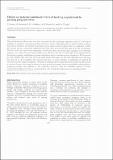Por favor, use este identificador para citar o enlazar a este item:
http://hdl.handle.net/10261/13363COMPARTIR / EXPORTAR:
 SHARE
BASE SHARE
BASE
|
|
| Visualizar otros formatos: MARC | Dublin Core | RDF | ORE | MODS | METS | DIDL | DATACITE | |

| Campo DC | Valor | Lengua/Idioma |
|---|---|---|
| dc.contributor.author | Frutos, Pilar | - |
| dc.contributor.author | Buratovich, Oswaldo | - |
| dc.contributor.author | Giráldez, Francisco Javier | - |
| dc.contributor.author | Mantecón, Ángel R. | - |
| dc.contributor.author | Wright, I. A. | - |
| dc.date.accessioned | 2009-06-01T09:47:07Z | - |
| dc.date.available | 2009-06-01T09:47:07Z | - |
| dc.date.issued | 1998 | - |
| dc.identifier.citation | Animal Science 66 (3): 667-673 (1998) | en_US |
| dc.identifier.issn | 1357-7298 | - |
| dc.identifier.uri | http://hdl.handle.net/10261/13363 | - |
| dc.description | 7 pages, 1 figure, 3 tables. | en_US |
| dc.description.abstract | Thirty single-bearing Merino ewes were used to examine the effect of feeding supplement, from 91 to 140 days of gestation, on changes in chemical composition of the ewes, on the relationships with live weight and body condition score and on the foetus. Ewes grazed a perennial ryegrass pasture and were offered either no supplement or 500 g per head per day of a concentrate supplement from days 30 to 90 and (or) from days 91 to 140 of pregnancy. Maternal carcass and non-carcass components, uterine wall, foetus and placenta plus cotyledons were chemically analysed. Live weight (LW) and body condition score (BCS) on day 140 were both affected by supplementation during late pregnancy, mobilization of protein and fat being lower in animals receiving supplement. BCS accounted for more variation than LW in the carcass fat depot. Because this depot was the most important source of energy from days 91 to 140 of gestation, this suggests that BCS is a useful estimator of mobilization of maternal fat reserves during this stage of pregnancy. The ability to mobilize reserves and protect foetal growth by Merino ewes in southern Europe, where large fluctuations in grass growth rate exposes them to considerable undernutrition as pregnancy proceeds, was confirmed in this experiment. However, when the nutritional regime is extreme, supplementary feeding to the ewes is recommended, in order to make the whole system economically profitable. | en_US |
| dc.description.sponsorship | This work was supported by the EU Commission (Project AIR CT 92-0646) and the Junta de Castilla y León (Project CSI 3/96). | en_US |
| dc.format.extent | 6026927 bytes | - |
| dc.format.mimetype | application/pdf | - |
| dc.language.iso | eng | en_US |
| dc.publisher | Cambridge University Press | en_US |
| dc.publisher | British Society of Animal Science | - |
| dc.rights | openAccess | en_US |
| dc.subject | Body condition | en_US |
| dc.subject | Ewes | en_US |
| dc.subject | Live weight | en_US |
| dc.subject | Pregnancy | en_US |
| dc.title | Effects on maternal and foetal traits of feeding supplement to grazing pregnant ewes | en_US |
| dc.type | artículo | en_US |
| dc.description.peerreviewed | Peer reviewed | en_US |
| dc.relation.publisherversion | http://www.bsas.org.uk/downloads/Vol66Part3_Jun_1998.pdf | en_US |
| dc.type.coar | http://purl.org/coar/resource_type/c_6501 | es_ES |
| item.fulltext | With Fulltext | - |
| item.languageiso639-1 | en | - |
| item.openairecristype | http://purl.org/coar/resource_type/c_18cf | - |
| item.openairetype | artículo | - |
| item.cerifentitytype | Publications | - |
| item.grantfulltext | open | - |
| Aparece en las colecciones: | (IGM) Artículos | |
Ficheros en este ítem:
| Fichero | Descripción | Tamaño | Formato | |
|---|---|---|---|---|
| Pub183.pdf | 5,89 MB | Adobe PDF |  Visualizar/Abrir |
CORE Recommender
Page view(s)
335
checked on 24-abr-2024
Download(s)
344
checked on 24-abr-2024
Google ScholarTM
Check
NOTA: Los ítems de Digital.CSIC están protegidos por copyright, con todos los derechos reservados, a menos que se indique lo contrario.
